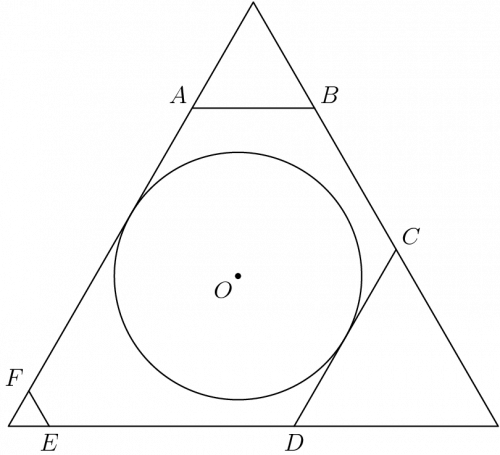Difference between revisions of "2018 AIME I Problems/Problem 8"
Elephant353 (talk | contribs) m (→Solution Diagram) |
(→Solutions) |
||
| Line 1: | Line 1: | ||
Let <math>ABCDEF</math> be an equiangular hexagon such that <math>AB=6, BC=8, CD=10</math>, and <math>DE=12</math>. Denote <math>d</math> the diameter of the largest circle that fits inside the hexagon. Find <math>d^2</math>. | Let <math>ABCDEF</math> be an equiangular hexagon such that <math>AB=6, BC=8, CD=10</math>, and <math>DE=12</math>. Denote <math>d</math> the diameter of the largest circle that fits inside the hexagon. Find <math>d^2</math>. | ||
| − | == | + | ==Solution 2== |
| + | Like solution 1, draw out the large equilateral triangle of side length <math>24</math>. | ||
==Solution Diagram== | ==Solution Diagram== | ||
Revision as of 05:42, 8 March 2018
Let ![]() be an equiangular hexagon such that
be an equiangular hexagon such that ![]() , and
, and ![]() . Denote
. Denote ![]() the diameter of the largest circle that fits inside the hexagon. Find
the diameter of the largest circle that fits inside the hexagon. Find ![]() .
.
Solution 2
Like solution 1, draw out the large equilateral triangle of side length ![]() .
.
Solution Diagram
- cooljoseph
First of all, draw a good diagram! This is always the key to solving any geometry problem. Once you draw it, realize that ![]() . Why? Because since the hexagon is equiangular, we can put an equilateral triangle around it, with side length
. Why? Because since the hexagon is equiangular, we can put an equilateral triangle around it, with side length ![]() . Then, if you drew it to scale, notice that the "widest" this circle can be according to
. Then, if you drew it to scale, notice that the "widest" this circle can be according to ![]() is
is ![]() . And it will be obvious that the sides won't be inside the circle, so our answer is
. And it will be obvious that the sides won't be inside the circle, so our answer is ![]() .
.
-expiLnCalc
See Also
| 2018 AIME I (Problems • Answer Key • Resources) | ||
| Preceded by Problem 7 |
Followed by Problem 9 | |
| 1 • 2 • 3 • 4 • 5 • 6 • 7 • 8 • 9 • 10 • 11 • 12 • 13 • 14 • 15 | ||
| All AIME Problems and Solutions | ||
The problems on this page are copyrighted by the Mathematical Association of America's American Mathematics Competitions. 










